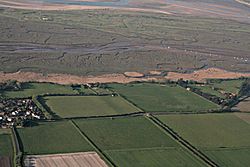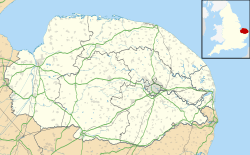Branodunum facts for kids
Quick facts for kids Branodunum |
|
|---|---|
| Norfolk, England, UK | |

Aerial view of Branodunum
|
|
|
Location in Norfolk
|
|
| Coordinates | 52°57′50″N 0°39′07″E / 52.9639°N 0.6519°E |
Branodunum was an ancient Roman fort. It was located in Norfolk, England, near the modern village of Brancaster. The name Branodunum comes from an old local language. It might mean "fort of the raven."
Contents
History of Branodunum
The fort was built around the 230s AD. It later became part of the Saxon Shore defense system. This system was a chain of forts along the coast. They protected the Roman Empire from sea attacks.
Branodunum was built to guard the entrance to The Wash. This is a large bay on England's east coast. The fort had a typical rectangular shape, like a Roman army camp called a castrum.
Who Guarded the Fort?
An old Roman document from the 4th century, called the Notitia Dignitatum, says that a group of cavalry (soldiers on horseback) from Dalmatia guarded the fort. They were called the Equites Dalmatae Brandodunenses.
However, a tile found at the site tells a different story. It has a stamp that says Cohors I Aquitanorum. This suggests that the first soldiers here were from Aquitania, a region in modern-day France. There is also some evidence, like old burials, that people from the Saxon period used the site later on.
What Remains Today?
The fort is located in a field east of Brancaster village. No modern buildings are on the exact fort site. However, houses built in the 1970s now cover much of the area to the west. This area was once a civilian settlement, or vicus, outside the fort.
Exploring the Fort's Design
The fort is bordered by Brancaster village to the west. The A149 road runs along its southern side. The National Trust takes care of the site. You can visit it for free from the A149 road or the Norfolk Coastal Walk.
How the Fort Was Built
In Roman times, the fort's northern wall was right on the seashore. This part of the coast served as a harbor for ships. Over many years, the shoreline has moved back. Now, the fort is further inland from the sea.
The fort was shaped like a rectangle with rounded corners. Its strong wall was about 10 feet (3 meters) wide. Inside the corners of the wall were turrets, which are small towers. Behind the wall was an earthen rampart. This was a sloped bank of earth that made the wall even stronger. It also helped soldiers get up to the battlements easily.
In front of the wall, there was a single V-shaped ditch. This ditch made it harder for enemies to reach the fort. The wall and ditch protected an area of about 2.56 hectares (about 6.3 acres).
Gates and Buildings
Like most Roman forts, Branodunum had four gates, one on each side. Parts of the eastern and western gates can still be seen. Evidence of towers next to the gates also remains.
Surveys from the air have shown that there were several buildings inside the fort. One important building was the principia. This was the main headquarters building for the fort's commander.
The Civilian Settlement
A civilian settlement, or vicus, grew up outside the fort. It was located on the eastern and northern sides. This settlement dates back to the 2nd century AD. Its size suggests it was one of the largest settlements in the area of the Iceni tribe.
The streets of this settlement do not line up with the fort's layout. This makes some historians think that an earlier fort might have been here. This first fort might have been made of wood. It could have been built as early as the mid-1st century AD, possibly during the revolt led by Queen Boudicca.
What's Left Today?
In the 1600s, parts of the fort's walls still stood up to 12 feet (3.7 meters) tall. But over the centuries, people took stones from the walls to use for other buildings. Because of this, only the outlines of the fort and its earthworks remain today.
The site of Branodunum was featured on the archaeology TV show Time Team in January 2013. The team made new discoveries that added to what we know about the fort.


